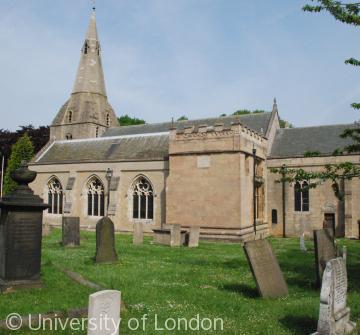Since the Middle Ages the parish church has been the fundamental unit of ecclesiastical organisation and pastoral care within the Established Church. Most were founded by secular lords on their own estates in the 11th or 12th centuries, a period which saw the final emergence of the pattern of towns, villages and parishes which continued (with some modifications) into the 19th century and beyond. Even today many parish churches stand near former manor houses, and parish boundaries can often be traced back to early manorial or estate boundaries. Ecclesiastical organisation earlier in the Anglo-Saxon period was more typically focused on minsters, a looser structure of large collegiate churches with responsibility over a wide area. Some former minster parishes comprised up to a dozen or more later parishes.
In theory every parish church had its own resident priest (the rector or vicar), who was supported by obligatory tithes and offerings from within the parish, and from land or glebe given at the church's foundation. Church attendance by those living within the parish was also obligatory, and in return the priest administered the sacraments and saw to the pastoral needs of his flock. Baptism, burial and marriage was reserved for the parish church, and as the associated fees could be substantial these rights were jealously guarded, often through litigation.
In reality, the endowments of individual churches and how well they were served varied enormously. From the 12th and 13th centuries reforming bishops strove hard to impose minimum standards, where necessary removing the worst offenders, and ensuring that priests were in full orders and had been adequately educated. A prerequisite of this was wresting appointment and dismissal of parish clergy from the laity, a battle which by the 13th century the Church had largely won. Thereafter, laymen could only present a candidate for the church to the bishop, who alone decided whether the priest was adequate.
Though most sizable villages had their own parish church by the 13th century, some smaller hamlets had only a chapel. This was a subordinate church, probably founded a little later, which had only limited and closely regulated rights. These varied, but might include services on Sundays and possibly a couple of other days, possibly baptismal rights, and (very rarely) burial rights. For everything else parishioners would still have to attend the parish church, and usually continued to pay their tithes and offerings to the rector or vicar. Some chapels were served (often very inadequately) by the rector or vicar himself, though at the opposite extreme were chapels which had their own endowment and chaplain, and were sometimes virtually parish churches in all but name. Rectors and vicars were understandably very reluctant to give up any of their rights or income to a neighbouring chapel, however, and although bishops occasionally interfered to ensure that a particular village was adequately served, from the 13th century it became very rare for a chapel to acquire full parochial status.
As the chief local focus of religion (and usually the village's largest and most substantial building), parish churches also became a focus of communal life. From the 13th century upkeep of the nave became the parishioners' responsibility, leading to the emergence of churchwardens to collect and administer church funds. Collectively or individually, parishioners frequently beautified or enlarged the church, spurred by a complex mixture of pious and more mundane motives. Burial within the church became a symbol of status within the community, reflected in the presence of brasses and other memorials both before and after the Reformation. Even in cities such as Norwich or London, which contained numerous parishes with intricate urban boundaries, the parish church remained an important focus, often acquiring side chapels and chantries, and being used for secular as well as religious purposes.
The Reformation made little difference to the centrality of the parish church, although changing beliefs led to major changes in internal furnishings, while the advent of married clergy presumably affected social relations between the priest and his parishioners. Demographic change during the 19th century led to major changes in parish boundaries, and in some areas to the building of new District churches to provide adequate pastoral care. Even so, the vast majority of old-established parish churches continued to provide the main religious focus for the surrounding community, at least in those places where religious nonconformity had not become a major rival to Anglican worship, or even eclipsed it. Tithe payment continued in most parishes until 1836 when it was commuted into a rent-charge, and incumbents' income only gradually became regulated during the 19th and early 20th centuries, principally through the work of the Ecclesiastical Commissioners.
In the late 20th and early 21st centuries the parish became less obviously central to Church organisation, as more and more of them became incorporated into extensive group ministries. Nonetheless, for many local communities the parish church remains a major social as well as religious focus.
 The 12th century parish church at Bolsover, of which only the 13th century tower survives from the medieval period, includes a chapel built by local l
The 12th century parish church at Bolsover, of which only the 13th century tower survives from the medieval period, includes a chapel built by local l









